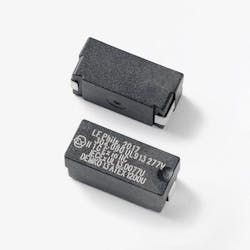Littelfuse Introduces First Encapsulated Surface Mount Fuse Designed for Intrinsic Safety Protection
Littelfuse, Inc., the global leader in circuit protection, today introduced the first encapsulated surface mount fuse designed for intrinsic safety protection of equipment intended for use in or near hazardous locations and explosive atmospheres and certified to the UL 913 Standard. During overcurrent and short circuit fault conditions, the 1mm-thick encapsulation around the body of the PICO® 304 Series surface mount fuse minimizes the amount of heat produced and contains any sparks or arcs inside the fuse assembly, preventing them from being exposed to potentially explosive gases or dust in the environment. This encapsulation eliminates the need to pot or coat printed circuit boards or assemblies, saving production time and money to reduce end-product costs.
The PICO® 304 Series is rated for 277V AC/DC with 1500A breaking capacity, making it suitable for barrier circuits and other circuits separating intrinsically safe circuits from non-intrinsically safe circuits. Available with current ratings from 50mA to 750mA, the series is ideal for limiting fault power available in a circuit, helping to reduce required power ratings and size of downstream components, wiring, and circuit board traces.
Typical applications for the PICO® 304 Series include measuring or processing electronic and electrical equipment, motor controllers, communication handsets/two-way radios and associated battery chargers, process control and automation equipment, sensors, lighting and flow/gas meters in the oil, gas, mining, chemical, pharmaceutical, food and beverage, and other process industries. (View the video.)
“The PICO® 304 Series fuse is the first surface mount fuse rated at least 250V with an encapsulated body,” said Tim Patel, global strategic marketing manager at Littelfuse. “This miniature fuse allows designers of intrinsically safe equipment to save board space while still meeting all certification requirements for intrinsic safety protection without the need for expensive and time-consuming encapsulation or coating processes.”
PICO® 304 Series Fuses offer these key benefits:
• Encapsulated and sealed design meets safety requirements for hazardous locations by preventing sparks from being exposed to potentially explosive gases or dust in the environment. Eliminating the need for potting or coating circuit boards saves time and money and reduces total
end-product cost.
• Because this series meets UL 913, IECEx, and ATEX standards for use in hazardous and potentially explosive atmospheres, it increases the overall safety of production and maintenance equipment in which it is used, and ultimately, the safety of employees working in hazardous locations.
• High breaking capacity rating of 1500A and current ratings ranging from 50mA to 750mA enable these intrinsically safe fuses to be designed into a broad variety of applications.
For more information, click here

